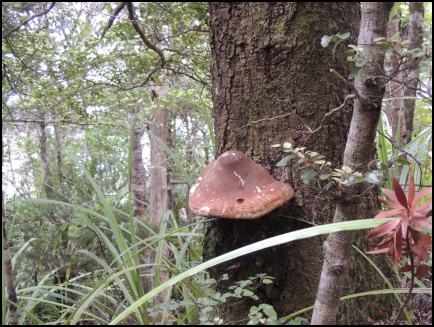Taking the Long View: Little Barrier Island
Taking the Long View Little Barrier Island:
Nature’s Ark in the Gulf
Gord StewartSeven a.m., Saturday morning, early December. Department of Conservation Office, Warkworth.
This was the staging point for a working weekend on Little Barrier Island, organised by the Hauturu/Little Barrier Island Supporters’ Trust.
Four times a year, a work party of ten led by a Trust member travels to the island to help out as needed and to enjoy and experience it first-hand. We considered ourselves the “lucky few” as Little Barrier is New Zealand’s premier – and oldest – nature reserve. Large signs warn boaties “No Landing” and part of the rangers’ job is to ensure just that.
 Little Barrier
Island, photograph courtesy of Random House
Books
Little Barrier
Island, photograph courtesy of Random House
BooksSome sense of what was in store for us arrived by post ahead of time: information on the island and its history, travel arrangements, what and how to pack, biosecurity conditions, and a quarantine checklist.
“Landing can be difficult, so be prepared to scramble ashore, if necessary, in waist-high waves over large slippery boulders,” warned the instructions.
But it was the biosecurity check that had us most on edge as we assembled that morning. Sue was the DOC “cop” charged with checking our belongings for items unwanted on the island – as simple as a few seeds stuck to a Velcro zipper. She had a great sense of humour, but only half-jokingly said, “No one ever passes!”
Little Barrier or Te Hauturu-o-Toi (“resting place of the wind” in Maori) sits 80 km north-east of Auckland in the Hauraki Gulf. Bought by the Crown in 1894, it was declared a reserve the following year. Roughly circular, the island is 3083 hectares in size and 722m at its highest point.
The island is volcanic in origin, mountainous, and heavily forested. It has a number of distinct vegetation zones and contains over 400 plant species.
Feral cats were successfully exterminated by 1980, kiore (Polynesian rats) by 2004, and the island is now free of introduced predators. Exotic (weed) species continue to reach the island, with pampas, climbing asparagus and Mexican devil still a big problem. (A “weed team” of five working on the island for three months was testament to the need for high biosecurity standards.)
Calm waters greeted us on arrival, and our stay proved to be a happy coexistence. There was no competition. No one was voted off the island. The group shared a fridge, bunk rooms, stories, and a true commitment to conservation.
Our work was far from onerous. We got stuck into tasks the rangers deemed important for care and upkeep at the time.
It was apparent Little Barrier is the place it is because so many people have cared about it, and worked hard on its behalf, for so long.
Tuatara are thriving with the predators gone. Then there is the Little Barrier Island giant weta, Duvaucels geckos and chevron skinks (14 species of reptiles in total), and our two remaining bat species.
And the forest is alive with birds. Over the years Little Barrier has served as an “ark”, with species under threat elsewhere brought to the island for safety – kokako, kakapo, black petrel and saddleback among them.
There are now more than 40 species of birds permanently or seasonally present on the island. Wood pigeons watched from branches above as we lunched on the bunkhouse deck. Cook’s petrels screamed in for a landing at night after a day at sea.

Little Barrier Island Forest, Photograph Supplied
This success story has been a real team effort. It starts, of course, with the Department of Conservation and its passionate rangers. Hauturu/Little Barrier Island Supporters’ Trust provides tremendous assistance in the form of fundraising, work parties, education, and other awareness-raising activities. Ngati Manuhiri, scientists and many volunteers contribute. Boaties (and the local fishing community) who understand and respect the restrictions play their part, too.
The Island Supporters’ Trust has raised funds for a short documentary now in production by NHNZ. Screenings of the film when ready will allow more people to get a sense of the beauty and significance of the island, and its place in New Zealand and world conservation efforts.
Lyn Wade, a trustee and Chairperson of the Trust, has been associated with the island since 1956, when she went there at the age of four with her father. He, in turn, had involvement as far back as 1932 when he researched the island’s vegetation as a part of his graduate studies.
“We’re so lucky to have it,” says Lyn of Little Barrier. “We can’t ever lose it.”
Gord
Stewart is an environmental sustainability consultant. He
does project work for government, industry, and non-profit
organisations.
More
Info
For more on the island and the work of the Trust, see www.littlebarrierisland.org.nz
For
further insights on Little Barrier and other important
wildlife sanctuaries around the county, see
Paradise Saved (Random House Books,
2014).


 Lynley Tulloch: Pulling The Mat Out From Under The Early Childhood Education (ECE) Sector
Lynley Tulloch: Pulling The Mat Out From Under The Early Childhood Education (ECE) Sector Howard Davis: NZSQ Inaugurates Wellington Chamber Music’s New Season
Howard Davis: NZSQ Inaugurates Wellington Chamber Music’s New Season Gordon Campbell: On The Trump Upside, And Peters Persecution Of Trans People
Gordon Campbell: On The Trump Upside, And Peters Persecution Of Trans People Binoy Kampmark: Yale, Ben-Gvir and Banning Palestinian Groups
Binoy Kampmark: Yale, Ben-Gvir and Banning Palestinian Groups Ramzy Baroud: The Myth Of Conquest - Why Gaza Will Never Be Subdued By Israel
Ramzy Baroud: The Myth Of Conquest - Why Gaza Will Never Be Subdued By Israel Binoy Kampmark: Fallibility, Dirty Wars And Pope Francis I
Binoy Kampmark: Fallibility, Dirty Wars And Pope Francis I